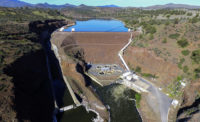Critics are slamming the federal government’s draft environmental impact statement (EIS) that rejects the notion of removing four hydroelectric dams from a network of 14 dams and reservoirs in the Columbia River basin as a way to protect endangered salmon and orca whales.
The U.S. Army Corps of Engineers, the Bureau of Reclamation and Bonneville Power Administration—the three entities responsible for overseeing the operations and maintenance of the network of massive dams in the Pacific Northwest United States—released their preferred plan, along with the other alternatives, on Feb. 28. The plans ranged from doing nothing and simply following the existing fish operations plan developed by the Corps in 2016, to removing four dams along the Snake River, where salmon populations have dwindled.
The “preferred alternative” includes both operational and structural projects that the agencies say would protect wildlife but not go as far as removing the dams, Ice Harbor, Lower Monumental, Little Goose and Lower Granite, which provide a 1,000 MW of carbon-free power for the region. According to the draft document, the preferred plan provides “flexibility to adapt to changing conditions in the Columbia River Basin, ensures that human life and safety can be protected through flood risk management, protects valuable fish and wildlife resources, supplies water for farmers and cities, and ensures adequate, affordable and reliable power.”
The main mechanism for protecting the fish in the preferred plan would allow water to spill over the dams to enable salmon passage during times when power generation is less valuable and spill less when power generation is more valuable.
For decades, environmental groups have fought to have dams removed along the Snake River, the largest tributary to the Columbia River. They say the dams interrupt the natural migration patterns for sockeye salmon and as a result, the fish populations are in danger of extinction. South Resident Orca whales, which feed on the salmon once they reach the Pacific Ocean, are also endangered, according to Columbia Riverkeeper.
Miles Johnson, a senior attorney with Columbia Riverkeeper, said in a statement, “It’s frustrating to see, once again, that the agencies charged with protecting endangered salmon from the dams are actually more interested in protecting the dams from salmon recovery efforts.”
The new draft EIS was required under a May 2016 decision by the U.S. District Court for the District of Oregon that found that federal agencies violated requirements under both the Endangered Species Act and the National Environmental Policy Act (NEPA). The court said the federal government’s actions to improve the habitat for the endangered fish were insufficient in protecting the endangered wildlife.
The agencies set a 45-day comment period for input on any of the alternatives following the Feb. 28 publication in the Federal Register. A final EIS is expected this summer, with a final record of decision in September.






Post a comment to this article
Report Abusive Comment